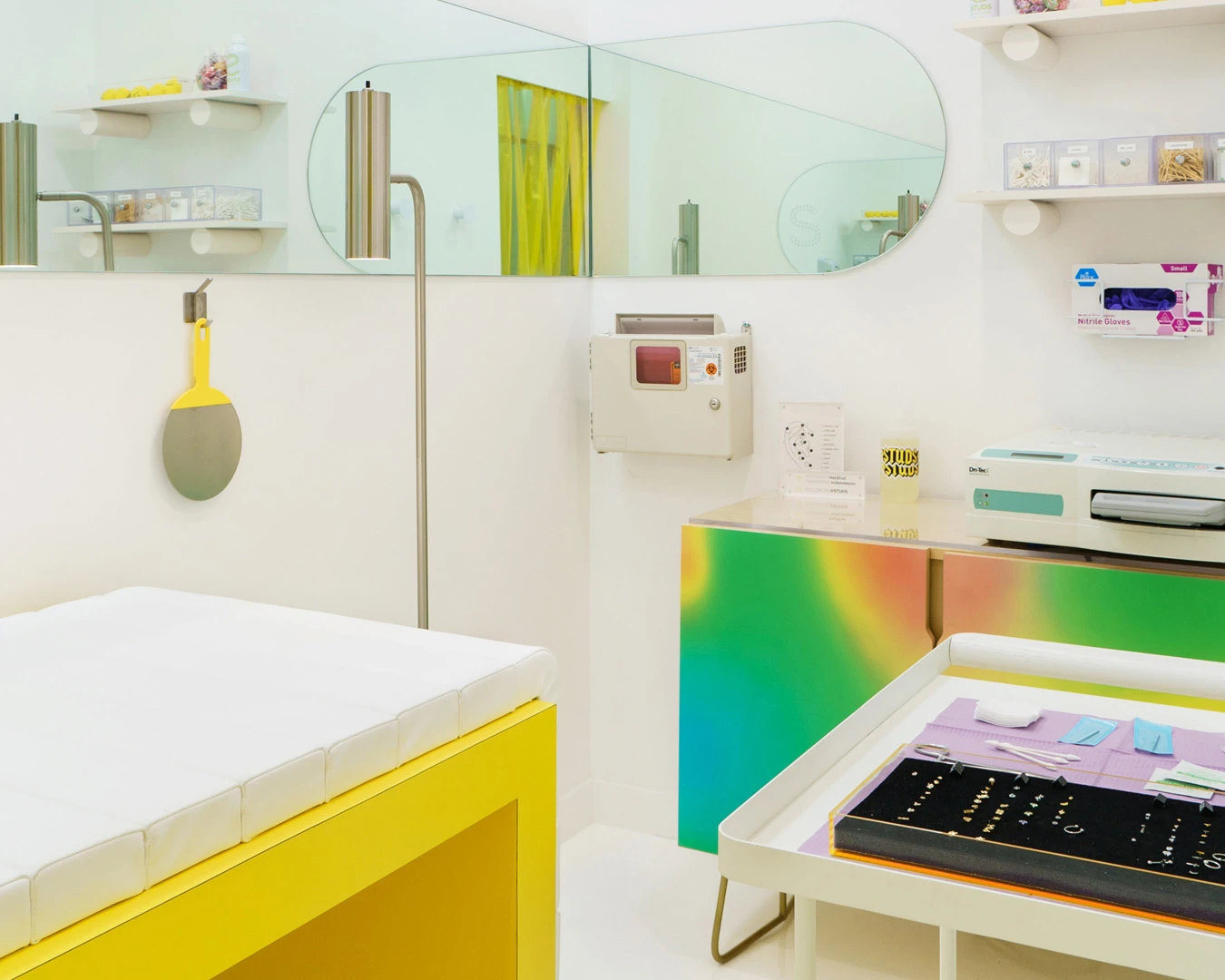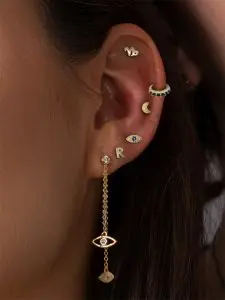“Hey, Stud,” beckons type printed on a wall as I stepped into Studs, the new piercing studio in New York’s Nolita district. I was there to check out the new store, jewelry collection, and to get my cartilage pierced, and was cheerfully greeted by cofounders Anna Harman and Lisa Bubbers, who had piercings of their own sparkling daintily across their ears.
A store associate asked if I’d like a water or Recess (the CBD-infused sparkling water), and I passed the neon-backdropped “Ear Bar” to sit down with the cofounders on silver stools to talk about how the concept came to be. Harman explained that the experience of getting piercings at a tattoo shop last year left her wanting more: It was expensive, and the jewelry choice was limited. The alternatives didn’t seem great either; there was the mall staple Claire’s, or expensive boutique jewelers. I could relate: This wasn’t my first piercing, but it was my first experience getting pierced outside of a mall. After going to the tattoo shop, Harman started looking into the retail piercing space, and saw a gap to fill.

With Studs, Harman wants to “modernize” the typical mall piercing experience for a new generation of Gen-Zers between the ages of 14 and 25 (though she says they’re also appealing to those age 25+), and respond to the challenges she encountered, making piercing a less intimidating, more affordable, and fashion-forward experience that younger consumers are used to. As much as Studs is a name, it’s also reflective of the company’s brand culture; a play on words that’s cheeky and positive, invoking an ethos their customer either already has or may have adopted by the time they leave the shop—with multiple cool-girl (or guy) piercings a tuck of the hair away.

The Bing Bang collection includes studs like a weed leaf, pearl, money sign, and skull. “The reason this collaboration is so special is because piercing assortments are typically either very limited or just plain boring by design,” says Harman. They also showcase independent designers, like Alterita, Yumono, and Repeller by Man Repeller, with more to come down the road.
All studs are sold individually so customers can mix and match, and “personalize an earscape”—a curated look with multiple piercings—”that’s uniquely you.” While the marijuana leaf was a little much for me, generally, the variety of high quality options was appealing, and the Ear Bar was effective. I landed on a cubic zirconia lightning bolt, but found myself eyeing more than one option and thinking about which piercing (and stud) I might get next.

The earrings range from $30-$180 per earring with a $35 charge for one piercing or $50 for two. Curated designs, with limited runs, builds return purchases into the customer experience—and an ongoing retail relationship beyond that first piercing.
It’s a strategy tailored to today’s retail landscape, brand continuity has to extend from brick-and-mortar space into the digital world, both in experience and design. “Gen Z’ers don’t differentiate between online and retail,” says Harman. “For them, it’s one experience with one brand. Studs is giving them the opportunity to get pierced in store and seamlessly continue the experience through whatever channels they prefer, whether it’s designing an earscape online or shopping for earrings in store.”

Studs isn’t alone. In the U.K., Astrid & Miyu is going for a similar approach, telling The Guardian, “We wanted to make ear stacking and mixing up your ear jewelry more accessible, by making it affordable without compromising on quality.” According to the same story, Astrid & Miyu is growing 200% year over year. There’s also Maria Tash, which offers high-end piercing and very trendy, high-cost jewelry options. Studs, for its part, recently secured 3 million dollars in funding from angel investors, including Lerer Hippeau and led by First Round Capital.
The success of brands like these is also an indication of how the retail landscape is still adapting to an era of e-commerce and increased expectations from consumers about in-store experiences. According to a Credit Suisse prediction in 2017, between 20% and 25% of malls are predicted to shut down over the next five years. Even in cases where brands are experimenting with physical space, it’s in a far more targeted way—and on a much smaller scale.
The retail experience of Gen-Z is simply trending to be different than the shopping experience I had as a teenager. I got my first piercings at Claire’s, alongside Lipsmackers. Glossier now meets the need for the latter, and Studs is aiming to appeal to earring fans who would have once visited the former. By combining well-designed in-person and online experiences that digital natives are used to, brands like Studs are hoping to forge a new hybrid model of physical and digital retail. And, as Studs says, “A hole new you.”
Recognize your brand’s excellence by applying to this year’s Brands That Matter Awards before the early-rate deadline, May 3.










